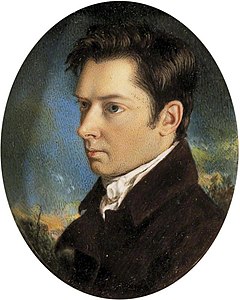
Back وليم هازلت Arabic وليم هازلت ARZ ویلیام هزلت AZB William Hazlitt Czech William Hazlitt CY William Hazlitt German Ουίλιαμ Χάζλιτ Greek William Hazlitt English William Hazlitt EO William Hazlitt Spanish
| Biografia | |
|---|---|
| Naixement | 10 abril 1778 Maidstone (Regne de la Gran Bretanya) |
| Mort | 18 setembre 1830 Londres |
| Residència | Hazlitt House (en) |
| Activitat | |
| Camp de treball | Filosofia |
| Ocupació | historiador de la literatura, periodista, pintor, crític literari, filòsof, escriptor, traductor |
| Obra | |
Obres destacables
| |
| Localització dels arxius | |
| Família | |
| Cònjuge | Sarah Stoddart Hazlitt (1808–1822) |
| Fills | unknown Hazlitt, William Hazlitt |
| Pares | William Hazlitt |
| Germans | John Hazlitt |
William Hazlitt (Maidstone, 10 d'abril de 1778 - Londres, 18 de setembre de 1830) va ser un assagista, crític dramàtic i literari, pintor, comentarista social i filòsof anglès. Ara és considerat un dels principals crítics i assagistes de la història de la llengua anglesa. en companyia de Samuel Johnson i George Orwell.[1][2][3][4] També és reconegut com el millor crític d'art de la seva època.[5] Tot i la seva alta posició entre els historiadors de la literatura i de l'art, el seu treball és poc llegit i principalment fora de catàleg.[6][7]
Durant la seva vida, va fer amistat amb moltes persones que ara formen part del cànon literari del segle xix, incloent Charles i Mary Lamb, Stendhal, Samuel Taylor Coleridge, William Wordsworth, i John Keats.[8]
- ↑ "A master of English prose style, a beautifully modulated general essayist, the first great theatre critic in English, the first great art critic, a magnificent political journalist and polemicist... Hazlitt is both a philosopher and one of the supreme literary critics in the language." Paulin, "Spirit".
- ↑ Jacques Barzun praises Lionel Trilling as just behind Hazlitt, implying that Hazlitt, ahead of Coleridge, Bagehot, and Arnold as well, is in the top rank of English-language literary critics. Quoted in Philip French, Three Honest Men: Edmund Wilson, F.R. Leavis, Lionel Trilling (Manchester, U.K.: Carcanet Press, 1980), cited in Rodden, Trilling, p. 3.
- ↑ "...in the tradition of the English essay, descended from Johnson, Lamb, Hazlitt, and Orwell", Hitchens on Display, by George Packer, in The New Yorker, 3 juliol 2008
- ↑ Irving Howe considered Orwell "the best English essayist since Hazlitt, perhaps since Dr Johnson". "George Orwell: 'As the bones know' ", by Irving Howe, Harper's Magazine, gener 1969.
- ↑ A.C. Grayling notes that Kenneth Clark "described Hazlitt as the 'best critic of art before Ruskin'." Grayling, p. 380. See also Bromwich, p. 20.
- ↑ "Most of Hazlitt's work is out of print, or unavailable in paperback. He is not studied in most university English courses...", Paulin, "Spirit".
- ↑ "Both Deane and Heaney had studied Hazlitt at school in Derry in the 1950s – he'd been replaced by Orwell when I took the same A-level course in the 60s, and the diminution of his reputation has been fairly steady until recently." Paulin, "Spirit".
- ↑ Grayling, pp. 209–10.
